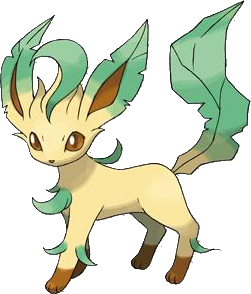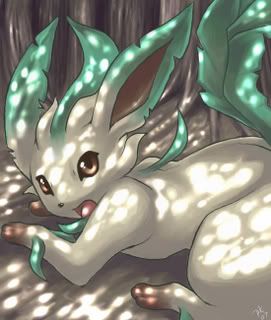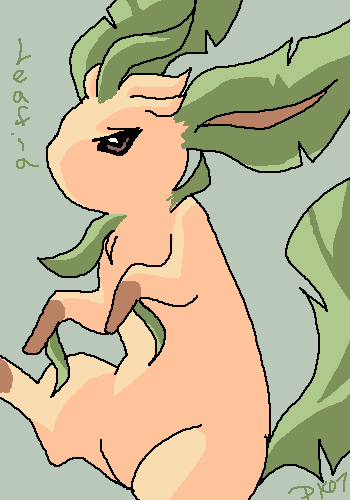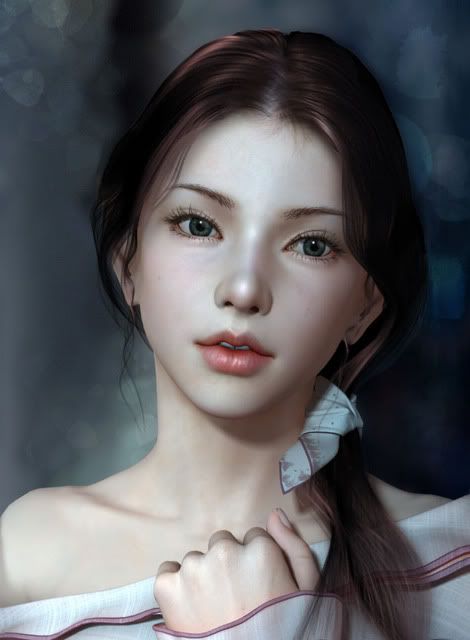 Japanese name:
Japanese name: Leafia
Evolves from: Eevee
Evolves into: None
Generation: Fourth
Species: Verdant Pokémon
Type: Grass
Height: 3 ft 3 in (1.0 m)
Weight: 56.0 lb (25.5 kg)
Ability: Leaf Guard
Base statsHP: 65
Attack: 110
Defense: 130
SpAtk: 60
SpDef: 65
Speed: 95
Leafeon (リーフィア, Rīfia?, Leafia in original Japanese language versions) is one of the 493 fictional species of Pokémon creatures from the multi-billion-dollar Pokémon media franchise – a collection of video games, anime, manga, books, trading cards and other media, created by Satoshi Tajiri. The purpose of Leafeon in the games, anime, and manga, as with all other Pokémon, is to battle both wild Pokémon, untamed creatures encountered while the player passes through various environments, and tamed Pokémon owned by Pokémon trainers.
Leafeon's name is derived from the word leaf, and -eon, a suffix which is common to, though not exclusively shared by, all names of Eevee evolutions.
Biological characteristicsLeafeon bears resemblance to a fox, as do most of the other evolved forms of Eevee, but falls into the height and weight range of the gray wolf. The body of a Leafeon is slender and limber. The fur is a light tan, almost a light beige, color with its paws colored a dark brown. The inside of their large ears is also dark brown. Its tail and ears are styled to resemble torn and tattered leaves. The coloring of Leafeon's tail and ears is mostly soft green, with a green horizontal stripe of a slightly lighter hue going across the middle and beige the rest of the way down. Its head is relatively large with the fur atop its head curling as if made to look like a cow-lick. Its large brown eyes are somewhat piercing, sinister, and entrancing and are cat-like in appearance. Besides the leaf-like ears and tails, there are a multitude of smaller leaves growing from their bodies; leaves grow out from the knee joint areas on the forelegs and hind legs, its chest, and its back. A larger, curled leaf grows from the middle of its forehead and is the same soft-green color of all the other leaves.
Leafeon employs photosynthesis on top of its animal capabilities. As a result, it is always surrounded by fresh air.
In the video gamesLeafeon made its first appearance in Pokémon Diamond and Pearl for the Nintendo DS, alongside many other Pokémon.
Leafeon can be evolved from Eevee by leveling it up in front of the Moss Rock, in the northwestern part of Eterna Forest in Pokémon Diamond and Pearl.

Leafeon's Leaf Guard ability, a new ability introduced in Pokémon Diamond and Pearl, is basically Safeguard in the form of an ability; it prevents all status conditions that could be inflicted on Leafeon when the weather condition is sunny.
Leafeon has exceptional Attack, incredibly high Defense, and an above average Speed stat, though its Special stats and its HP are sub-par. It learns Leaf Blade, a move previously exclusive to Grovyle and Sceptile.
PhysiologyLeafeon is a fox-like creature with some plant, dog, and cat parts. Its body is tan colored. It has one shade of dark brown that is carried out on the tip of its paws, as its eye colour, and in the center of the ear. It has sprouts growing all over it, making it look more like a plant. It has a longer sprout of its forehead. Leafeon has a leaf-like tail.
Gender differencesNone.
Special abilitiesLeafeon can use any attack that Eevee knows with the addition of Grass-type attacks. As a fully evolved Pokémon, Leafeon can learn either Hyper Beam or Giga Impact. It can also clean the air around it.
BehaviorLike most Grass-types, it is probably gentle. Seeing as it has not been seen yet in the anime, not much of its behavior is known currently.
 Habitat
HabitatAs an Eevee, it chooses to live anywhere it wants. From there, it can evolve to its surroundings. In this case, Eevee has lived in a forest and evolved into Leafeon.
DietBaitFirst introduced in the Generation I games and used in the Safari Zone, this food will make a wild Pokémon less likely to run away but more difficult to catch. An unlimited supply of Bait is provided for use in the Safari Zone.
BerriesFirst introduced in the Generation II games, berries are a type of item which, unlike Potions or Vitamins, are portrayed as food rather than Medicine. A Pokémon may hold this item and, if needed, eat it during a battle to heal itself or cause other effects.
Pokéblocks First introduced in the Generation III games, Pokéblocks are a type of candy which are blended from berries and given to a Pokémon to raise its condition in several areas. The flavor, level, and feel of the Pokéblock is determined by the ingredients which compose it and how well it is blended.
A Pokémon can only eat a certain number of Pokéblocks before it is full and cannot eat any more. The lower the feel of the Pokéblock, the less it fills the Pokémon up, and the more Pokéblocks a Pokémon can eat.
Pokéblocks can also be put on a feeder in the Safari Zone to lure wild Pokémon out. After being there for a while, however, the Pokéblock will eventually be eaten. It can also be used in encounters in the Safari Zone in the same manner as bait.
 Poffins
PoffinsFirst introduced in Generation IV, Poffins are similar to Pokéblocks. A Poffin will raise the the condition of a Pokémon in at least one of five categories: Smart, Cute, Tough, Beauty, and Cool. The flavor and feel of a Poffin is still taken into account just as in a Pokéblock. The main difference is that Poffins are pastries and Pokéblocks are candy.
ApplesIn Pokémon Snap, one of the few items provided is Pokémon Food. This is an unlimited supply of apples which Todd can throw to the wild Pokémon. Many Pokémon will happily eat the food, and it can be used to lure them to a new spot since they may walk to where the food was thrown. A well-aimed throw may also hit the Pokémon with the apple, causing them to flinch or become upset.
Professor Oak will provide Todd with Pokémon Food after he obtains a total score of 14,000 points in the Pokémon Report.
PokéSnacksThese are used in Pokémon XD: Gale of Darkness to lure wild Pokémon to PokéSpots. They look like a slice of a yellow cake, with each slice being one-tenth of the cake. Up to ten can be placed at each PokéSpot.
The P*DA monitors the PokéSnacks at each PokéSpot, and will inform Michael how many are at each PokéSpot and when a wild Pokémon is eating them. If Michael doesn't return to the PokéSpot quickly, the wild Pokémon may eat all the PokéSnacks he had there.
Sometimes a Munchlax will appear at a PokéSpot. When this happens, its trainer will arrive, apologize, and give ten new PokéSnacks for any the Munchlax may have eaten.
 Weakness
Weakness Flying: 2×
Poison: 2×
Bug: 2×
Fire: 2×
Ice: 2×
ResistanceGround: ½×
Grass: ½×
Water: ½×
Electric: ½×
Normal: 1×
Fighting: 1×
Rock: 1×
Ghost: 1×
Steel: 1×
Psychic: 1×
Dragon: 1×
Dark: 1×
By leveling upStart Tackle, Tail Whip, Helping Hand
8 Sand-Attack
15 Razor Leaf
22 Quick Attack
29 Synthesis
36 Magical Leaf
43 Giga Drain
50 Last Resort
57 Grasswhistle
64 Sunny Day
71 Leaf Blade
By TM/HM TM05 Roar
TM06 Toxic
TM09 Bullet Seed
TM10 Hidden Power
TM11 Sunny Day
TM15 Hyper Beam
TM17 Protect
TM18 Rain Dance
TM19 Giga Drain
TM21 Frustration
TM22 Solarbeam
TM23 Iron Tail
TM27 Return
TM28 Dig
TM30 Shadow Ball
TM32 Double Team
TM40 Aerial Ace
TM42 Facade
TM43 Secret Power
TM44 Rest
TM45 Attract
TM53 Energy Ball
TM58 Endure
TM68 Giga Impact
TM70 Flash
TM75 Swords Dance
TM78 Captivate
TM81 X-scissor
TM82 Sleep Talk
TM83 Natural Gift
TM86 Grass Knot
TM87 Swagger
TM90 Substitute
HM04 Strength
HM06 Rock Smash




 Leafeon's Leaf Guard ability, a new ability introduced in Pokémon Diamond and Pearl, is basically Safeguard in the form of an ability; it prevents all status conditions that could be inflicted on Leafeon when the weather condition is sunny.
Leafeon's Leaf Guard ability, a new ability introduced in Pokémon Diamond and Pearl, is basically Safeguard in the form of an ability; it prevents all status conditions that could be inflicted on Leafeon when the weather condition is sunny. Habitat
Habitat Poffins
Poffins